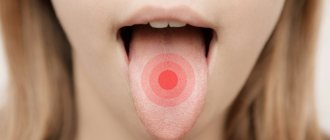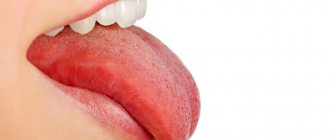Why does my tongue hurt at the tip, bottom or side?
Among the causes of pain in various areas of the tongue, mechanical damage or thermal burns are most often noted. To find out exactly why the tongue hurts, in each specific case it is worth dealing with the support of an experienced doctor. As a result of examination, surveys and thorough diagnosis, it is possible to determine one of the following causes of pain:
- Accidental cuts, bruises, burns or bites while eating, getting cosmetic punctures or talking;
- Inflammatory processes of the mucous membranes of the oral cavity of fungal or viral origin;
- Allergic reactions when taking specific foods or medications;
- Neuralgic reactions as a result of stressful situations or severe mental trauma;
- Improper functioning of the salivary glands;
- The presence of undiagnosed diseases of organs and body systems (digestive, cardiovascular, endocrine systems);
- Development of oncological diseases of the oral cavity.
Glossitis - symptoms and treatment
Folded or scrotal tongue. The term “scrotal tongue” comes from the external similarity of the affected tongue to the skin of the scrotum (from the Latin scrotum - scrotum). With this form of glossitis, a deep central groove runs along the back of the tongue with adjacent cracks and folds, which can be located longitudinally or randomly. The tongue is slightly enlarged [5]. Due to atrophy of the filiform papillae, it may look “smoothed out”, but this does not affect the taste sensation [16].
Diamond-shaped or median glossitis. This is a chronic disease of the mucous membrane of the tongue with partial or complete absence of filiform papillae closer to the posterior third of the tongue. The lesion has a diamond shape, a dense texture and a red varnished color. Usually it has clear contours and does not protrude above the mucous membrane. The lesion does not cause pain, but some patients perceive it as an aesthetic defect.
Other forms of rhomboid glossitis are less common - with tuberous outgrowths and papillomatous growths. The patient then feels the presence of a foreign body on the tongue [5][16].
Desquamative or “geographical” language. With this form of glossitis, the keratinization of the tongue is partially disrupted with signs of desquamation of the epithelium - desquamation (Latin desquamo - remove scales). The papillae of a significant part of the surface of the back of the tongue are changed. The lesions take on the appearance of red spots with a diameter of 0.5 cm and desquamated whitish epithelium along the edges. The spots can merge with each other and create a pattern similar to a geographical map.
Patients often complain of pain and burning when eating food or drinks that irritate the oral mucosa, and some of them note a short-term loss of taste.
There are two forms of desquamative glossitis: migrating and fixed [16].
The fixed form is more common with moderate damage to the stomach by the bacterium Helicobacter pylori. The disease is usually accompanied by persistent atrophy and smoothness of the filiform papillae of the tongue. The size and location of the lesions does not change.
The migratory form occurs when the stomach is heavily colonized with H. pylori. Foci of desquamation are up to 2 cm in diameter, their location is constantly changing.
Also, with desquamative glossitis, the tongue may increase in volume due to inflammation of the fungiform papillae, which are located at its root. They reach 0.8 cm in diameter and are covered with a white or light gray dense coating [14].
Black "hairy" tongue. This is a rare lesion in which the keratinized epithelium of the filiform papillae located in the posterior and middle third of the dorsum of the tongue does not slough off. Because of this, the papillae acquire a brown or black color, become stiffer, grow up to 2-3 cm, and are covered with a coating ranging from green and light brown to black [16].
The tongue takes on an unaesthetic appearance, patients complain of the sensation of a foreign body in the mouth and the appearance of a gag reflex [4].
Diseases of the gastrointestinal tract. A sign of damage to the gastrointestinal tract is a grayish-white coating on the back surface of the back of the tongue. There are no pain or any other subjective sensations.
Another manifestation of gastrointestinal tract damage is swelling of the tongue with tooth marks on its lateral surfaces without visible relief disturbances. At the same time, patients may be bothered by constant biting and burning when eating hot and spicy foods. The fungiform papillae located at the root of the tongue may also enlarge. They become bright red and rise above the surrounding tissue. The listed symptoms may accompany gastritis, gastric and duodenal ulcers[5].
With hepatitis A, areas of desquamation appear on the back of the tongue. Due to atrophy of the filiform papillae, the tongue becomes smooth and red. Patients often complain that the taste of sweet and bitter foods has become less pronounced [5].
Liver cirrhosis is manifested by swelling of the sublingual veins, atrophy of the oral mucosa and deepening of the natural folds of the tongue.
Lesions of the pancreas. In acute pancreatitis, the tongue becomes covered with a yellow-white coating, and the filiform papillae increase in size. Patients are often concerned about its dryness and disturbances in taste sensitivity.
In chronic pancreatitis, a secondary deficiency of B vitamins occurs, which is manifested by pain in the tongue and protruding bright red fungiform papillae. The tongue increases in size, becomes smooth and shiny.
Cardiovascular pathology. With hypertension, blisters with bloody contents are often present on the tongue, the so-called “vesical” symptom. They can suddenly appear and burst on their own, damaging the epithelium.
Diseases of the endocrine system. With diabetes, the body is dehydrated, so dryness appears, and the vessels of the tongue become overfilled with blood. A burning sensation occurs and long-healing ulcers form. Very often, symptomatic candidiasis is found on the tongue, especially if the patient does not regulate blood glucose levels.
Insufficient function of the thyroid gland, or hypothyroidism, leads to enlargement of the entire tongue or part of it and swelling, which does not form a dimple when pressed. Due to high cholesterol levels, the tongue is slightly yellowish in color.
Diseases of the blood and hematopoietic organs. With iron deficiency anemia, there is a need to eat unusual substances, such as chalk, clay, as well as a burning sensation and pain in the tongue. It is often pale in color and slightly increased in size.
With Addison-Beermer anemia, which occurs due to impaired absorption of vitamin B12, the filiform muscles weaken. The tongue becomes smooth and as if “polished”. This condition was called “Gunter's glossitis.” Painful red inflammatory streaks and spots appear. The tongue or just its tip turns bright red, and a tingling and burning sensation occurs [5].
Acute leukemia is manifested by ulcers of irregular shapes without clear boundaries with a necrotic coating on the tongue, without rims of hyperemia (overflow of blood vessels) along the edges. Pinpoint and small blood spots and hematomas may also appear on the mucous membrane of the tongue. One of the main symptoms of this condition is heavy bleeding.
Chronic leukemia occurs much less frequently than acute leukemia and lasts longer. Characteristic ulcers and leukemic infiltrates (fluid accumulation) appear on the tongue. At the acute and chronic stages of leukemia, they lead to the formation of ulcerative-necrotic lesions, which are difficult to treat.
Agranulocytosis is characterized by a significant decrease in the blood of granulocytes - a type of leukocyte, “protective” blood cells. The disease manifests itself as non-demarcated ulcers on the tongue and, unlike acute leukemia, an inflammatory reaction around them. Due to decreased immunity and the resulting increased susceptibility of the body to fungal diseases, candidiasis may develop.
Changes in the tongue due to hypo- and avitaminosis:
- hypovitaminosis A - dryness of the mucous membrane of the tongue and a tendency to increased keratinization of the skin (hyperkeratosis);
- hypovitaminosis C - swelling of the tongue with teeth marks on it; ulcerative necrotic lesions, usually covering a significant surface area of the tongue mucosa;
- hypovitaminosis PP causes a disease called “pellagra”, in which peeling of the surface layers of the epithelium occurs and a burning sensation of the tongue, it becomes smooth, shiny and crimson - the so-called “cardinal tongue”;
- hypovitaminosis B1 is characterized by pain in the tongue and the appearance of blisters;
- hypovitaminosis B2 is manifested by burning of the tongue, atrophy of the papillae and angular cheilitis - cracks in the corners of the mouth [4].
When infected with herpes simplex virus type 1 (HSV-1), patients complain of burning pain in the tongue. Upon examination, a deep crack is visible along its midline with several branches. In their depths there are painful blistering rashes, which over time burst with the formation of erosions.
Burning mouth syndrome. In the area of the tongue there is a feeling of a burn, paroxysmal burning pain, which intensifies with overwork and stress.
Galvanism. Patients experience a metallic taste in the mouth and rawness. Upon external examination, the tongue is swollen, its vessels are filled with blood, “bald spots” of the papillae and bright red erosions appear on its sides [5].
Discomfort in the lateral areas of the tongue
When the tongue hurts on the side of any side, the causes of the discomfort may be a discrepancy in the size of the dentures, inflammation of the mucous membranes, heavy smoking, or characteristic neuralgic manifestations.
Pain on the tip of the tongue
The tip of the tongue is constantly in contact with the teeth and is actively involved in the process of creating sounds, therefore it causes special discomfort to people. The most common reasons for this condition are:
- Minor injuries at the end of the tongue
occur most often, since it is this area that first encounters food, dentures and teeth.
- Glossalgia
accompanied by a burning sensation, as well as the possibility of pain spreading to other parts of the oral cavity.
- Glossitis
– inflammatory disease of the oral cavity.
- Stomatitis
causes small painful wounds at the end of the organ.
- Allergic manifestations
occur as a result of immediate contact with certain medications or foods.
Pain under the tongue at the base
Pain at the base of the tongue is a strong irritant for a person; it interferes with talking and eating, significantly worsening the patient’s quality of life. There are several causes of pain at the root:
- With glossalgia, pain can be localized both at the tip of the tongue and at its base, it all depends on the structural features of the patient’s tongue.
- With allergies, almost any part of the tongue can also hurt.
- Diseases of the gastrointestinal tract can provoke severe pain at the root of the tongue, which annoys the patient for a long time.
- With vitamin deficiency, patients complain of tingling and pain at the base.
- The most serious causes of soreness at the base of the tongue are cellulitis and abscess. Symptoms of these diseases are severe acute pain at the base of the tongue, the inability to close the mouth, bad breath, increased salivation, in which saliva constantly drips from the mouth. The patient's tongue swells, causing speech impairment and difficulty breathing. Both abscess and phlegmon are extremely dangerous diseases, so if you notice at least one of the above symptoms, you should immediately consult a doctor.
What to do if your tongue hurts?
If you experience pain in any area of the tongue, you should make an appointment with a dentist or otolaryngologist. Before going to the clinic, it is necessary to exclude the presence of minor injuries or accidental burns, for which it is important to leave time to heal. If the cause of the pain was a cosmetic puncture, you must strictly adhere to all recommendations and carefully monitor oral hygiene. If your tongue hurts without punctures or wounds, you should consider one of the following options:
- Carrying out dental procedures
with surgery: anesthesia and medical procedures cause swelling of the gums and a small area of the tongue. The discomfort usually goes away as the swelling decreases.
- Inflammatory and fungal diseases of the oral cavity
eliminated by taking antifungal agents and maintaining constant cleanliness in the mouth.
- Inflammatory and infectious diseases of the upper respiratory tract
: sore throat, sore tongue - signs of inflammation of the tonsils or submandibular lymph nodes. The otolaryngologist will draw up a treatment regimen with the prescription of antiviral, painkillers and antihistamines.
Are you worried about short-term or constant pain in different areas of the tongue?
Try to find out the causes of discomfort, remember cases of injury or accidental burns. If pain continues to bother you, you should immediately consult a therapist, dentist or otolaryngologist. An experienced doctor will conduct all the necessary studies and take tests to accurately determine the diagnosis and create an effective treatment regimen. This article is for informational purposes only, please consult your doctor for details! Ask your doctor about contraindications and side effects.
Soreness on the sides of the tongue
- If a patient complains of pain on the lateral surfaces of the tongue, the main reasons for their occurrence are most likely the same mechanical injuries, glossalgia or glossitis, allergic reactions and stomatitis. Often the tongue hurts on the sides due to poorly fitted dentures, which constantly injure the mucous membrane with its sharp edges.
- If the patient smokes a lot, this can also cause severe pain.
- If there is no apparent reason for the soreness of the tongue, and yet it hurts almost constantly, neuralgia should be suspected.
In any case, if your tongue is painful, you should consult a doctor; only he can make the correct diagnosis and prescribe appropriate treatment.
Symptoms of pain in the tailbone
Pain in the coccyx has a variety of manifestations. They can be aching, convulsive, sharp, braining, burning, pulling, bursting, etc. They often radiate to the sacral, gluteal region, genitals, and thighs.
When changing body position, the intensity of pain decreases or disappears without taking painkillers. Attacks can be either rare and mild or frequent and painful. There may be constant negative sensations over a long period of time, which are characterized by a sudden beginning and the same ending.
In most cases, attacks occur at night, during sneezing, coughing, physical stress, sports training, or intimacy. Pain in the coccyx is most severe when sitting on hard surfaces and decreases when walking. Gases and feces put pressure on the rectum, so bowel movements are sometimes painful, followed by temporary relief.
Localization of pain
The main symptom of coccydynia is pain, which is localized in the following places.
- Directly in the tailbone. As a rule, pain in the tailbone occurs when sitting, standing up and bending. It intensifies with strong pressure on the lower spine and after physical activity.
- In the anus. Pain occurs suddenly, mainly at night or during sexual intercourse, as well as during bowel movements.
Movements become constrained and cautious, the gait becomes slow and waddles (like a duck). This is fraught with scoliotic changes in the spinal column, joint deformation, and muscle strain. It is possible that constipation, difficulties with deurination, and sexual dysfunction may occur. The result is a deterioration in the emotional state: the emergence of fears, irritability, depression, fatigue, insomnia.
Possible autonomic reactions of the body to pain in the tailbone: increased sweating, peripheral incoming vasospasm (vasospasm), intestinal upset, vomiting.
The disease is characterized by a chronic course. It worsens mainly in the autumn-winter period, after stressful situations, general hypothermia, excessive or unusual physical activity.
If the cause of pain in the coccyx is an injury, the pain syndrome is severe, and the appearance of hematomas, swelling and swelling in the damaged area cannot be ruled out.
How to get rid of pain on your own?
Regular use of folk remedies will soothe irritated mucous membranes, relieve inflammation, accelerate tissue regeneration, and relieve a person from pain and discomfort.
Sage decoction
Sage has active anti-inflammatory properties.
Preparation:
- 10 gr. pour 200 ml of dry plant material. boiling water;
- pour the mixture into a thermos and leave for a couple of hours.
Rinse your mouth with sage decoction three times a day. During the therapeutic procedure, try to “hold” the healing decoction as long as possible near the inflamed tip of the tongue.
Honey
Many people know about the healing properties of beekeeping products. Honey has antibacterial, anti-inflammatory, wound healing, analgesic and other important qualities.
Honey is used to treat various diseases, including stomatitis and traumatic injuries to the mucous membrane of the tongue.
Method of treatment:
- rinse your mouth with clean water;
- put 1/2 teaspoon of honey on the tip;
- keep the product in your mouth until it is completely dissolved.
The procedure can be repeated up to 5 times a day. The recipe can only be used if there are no allergic reactions to bee products.
People suffering from diabetes or obesity are advised to choose a different method. This is due to the fact that honey contains a large amount of sugar.
Painkillers
In case of acute pain, it is recommended to rinse the mouth with anesthetic solutions - Lidocaine, Novocaine, Anestezin.
For moderate pain, it is more effective to use medications that simultaneously alleviate pain and disinfect - Miramistin, Furacilin.
3. Glossitis
Glossitis should not be confused with glossalgia, since it is an inflammatory disease that affects the mucous membrane of the tongue. It is manifested by swelling and increased sensitivity of the entire surface. It is provoked by bacteria, viruses, that is, it is of infectious origin. In the absence of proper and timely treatment, it can lead to the appearance of ulcers, cracks and erosions. Main symptoms: burning, redness and enlargement of the tongue, increased salivation, difficulty eating and speaking.
Glossitis
The disease is treated with antiseptics and anesthetics applied locally. If necessary, the doctor prescribes anti-inflammatory drugs and antibiotics.










